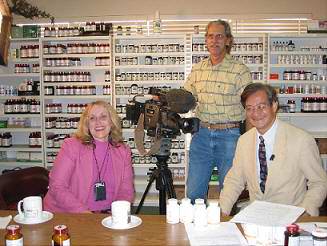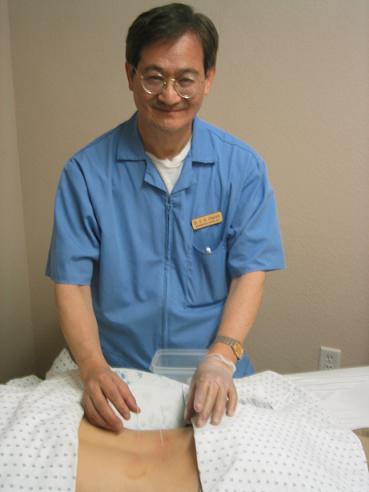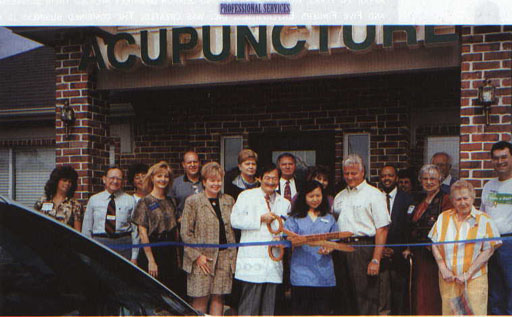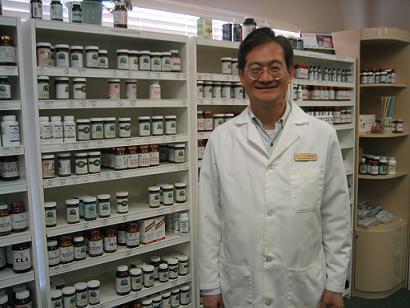|
 ABC Evening News
"Healthy Her", Herbology, 11/13/2006
(TOP
ABC Evening News
"Healthy Her", Herbology, 11/13/2006
(TOP ) )
Healthy Her: Herbology
"Herbs and their power to help you
fight the flu, depression and even improve your fertility!"


Reporter:
Today we are looking at the effects of herbs. It's not main stream
modern medicine, but supporters of herbology said it works for
everything, from the common cold to depression, and even fertility. And
its root goes back thousand of years.
Mrs. Garrett has
two very good reasons to believe in herbology — a two-year-old girl and
a two-month-old boy.
Garrett turned
to a certified herbologist, Dr. Chernly, after years of trying to have a
baby and thousands of dollars spent on infertility treatments.
Garrett: "He put me on a three-month plan. I think the first two weeks I
went to the clinic twice a week and after that I went once a week. And
all I was taking were the herbs and vitamins, which was everything they
are giving to me and suggesting."
Reporter:
Garrett was skeptical at first trying something so untraditional.
Garrett: "I didn't know what to expect. And at the time he said he had
about ten patients that he was treating for that."
Reporter: Any doubts she had were quickly gone.
Garrett: "And about a month later, I went in for my appointment and said 'I
am pregnant!!'"
Reporter: Infertility (Fertility
Formula) is one of many reasons herbs are used for. St. John Wort
is used for many years to treat mild depression.
Dr. Chernly: "This kind of herb (Pueraria
Flu Formula) is good for the cold."
Reporter: From the flu to sinus (Nasal
Cleanser) and bronchitis (Lung
Cleanser), herbs have been used to heal the sick for centuries, long
before the local drug store open its door.
Dr. Chernly: "Without herbs, we don't have contemporary, modern drugs. Sixty
to seventy percent of the modern drugs were originated from those
herbs."
Reporter: Herbology isn't the main stream and it's often dismissed by the
traditional doctor. But its supporters are growing.
Garrett: "First time I thought it may be a coincident. But even if it was
a coincidence, the other more main stream type things did not work. But
when it worked the second time, so quickly, I was so sure!!"
(See
Garrett's Testimony)
Page 2A
The Courier, 02/25/2005
(TOP ) )
Acupuncture: Another Answer
"Western medicine didn't make me well.
Chinese medicine did. I could make a bigger contribution to the U.S. by
practicing Chinese medicine."
~
Dr. Chung-Hwei Chernly, Acupuncturist.
By Leslie Rigoulot
A recent medical study found that acupuncture is better
than drugs alone for the treatment of osteoarthritis of the knee. Since
knee pain affects almost one-tenth of the population over the age of 55,
this study has garnered international attention.
Dr. Chung-Hwei Chernly
isn’t surprised, but also isn’t in need of a British Medical Journal
study to tell him what he already knows. “It is nice to have your
beliefs confirmed, but I have over 15,000 patients who tell me the same
thing and more,” said the Hurst doctor.
“I studied Western Medicine in Taiwan,” said
Chernly, a native of that country. “I
suffered with back and leg pain from the time I was 19 until I was 32. I
thought Western medicine would help. I had different diagnoses from a
ruptured disk to pinched nerve.”
Chernly, who became a
flight surgeon in the Taiwanese Air Force, eventually sought out a
friend from medical school and pressed his friend to perform surgery.
“He didn’t want to do it because it doesn’t always work,”
Chernly said.
His mother reminded him about acupuncture and he decided
to give it a try before finding another surgeon. “After couple months,
all the symptoms were gone.” Chernly
said. “I was so impressed, because even with the pain medicine, the pain
had always been there as an undercurrent. Now it was gone.”
Using a research grant from his medical school, he began
to study acupuncture in Taiwan. “People were skeptical, but I had had 13
years of pain. There were no MRIs back then. [My desire] to study
acupuncture was based on my own functionality.”
In 1979, Chernly came
to the United States for advanced studies at what is now the UT
Southwest Medical Center. After his studies were finished he had a
choice to make. “Western medicine didn’t make me well,” he said.
“Chinese medicine did. I could make a bigger contribution to the U.S. by
practicing Chinese medicine.”
There wasn’t any licensing set up in Texas at the time so
he had be sponsored by a medical doctor and have a license from another
state. In 1992 when Texas laws changed, Dr.
Chung-Hwei Chernly received acupuncture license No.00001.
“The United States is a great nation that is now
accepting acupuncture, “Chernly
said. “If it works, the people here will try it. I have over 90 percent
success rate with pain control.”
“But the FDA, the AMA and some insurance companies will
point to a few flawed studies to deny coverage,”
Chernly added. “Everybody can shoot a
basketball. But Michael Jordan is the one who gets results. The studies
may not have used a skilled acupuncturist. The FDA doesn’t recognize
acupuncture. And Medicare won’t cover acupuncture because the FDA won’t
recognize it. And the insurance companies follow the Medicare
guidelines.” Chernly shakes his
head.
“I encourage more medical, chiropractic and osteopathic
doctors to study acupuncture,” Chernly
said. “People need this.”
Leslie
Miner, a Grapevine chiropractor and acupuncturist, agrees. “I got into
acupuncture when I was 25 and in pain. In ancient China, you paid your
doctor to keep you healthy. You didn’t pay him if you got sick. In
Western medicine, we only pay our doctors when we’re sick. We don’t pau
anyone to keep us healthy, which is what we want to be,” she said with a
laugh.
From
AARP, May-June, 2004
(TOP ) )
|
Illustration by Francisco Caceres |
Vetoing
Surgery
By
Melissa Gotthardt
How the jogger-in-chief can ease his
knee pain
Presidential privilege doesn't extend to knees: George W. Bush recently
became one of the 21 million Americans who suffer from osteoarthritis
(OA). His trouble spot: his knees. Dubya's docs prescribed low-impact
exercise—bicycling and swimming instead of his almost-daily running
habit—and weight loss (dropping just 11 pounds can lower arthritis risk
by 50 percent). More drastic remedies include total knee replacement,
but some alternatives for the Prez or anyone with knee pain include:
Acupuncture
A
National Institutes of Health (NIH) study found that twice-weekly
acupuncture sessions reduced subjects' osteoarthritis-related knee pain
by an average of 44 percent within eight weeks. In a small Scandinavian
study, six months of acupuncture produced major improvements in range of
motion and pain in OA sufferers facing total knee replacement.
One-quarter of the patients decided to forgo surgery altogether. Initial
treatments typically last 10 to 12 weeks.
Hyaluronic Acid (HA)
A
synthetic form of a substance found in the knee, HA injections can
improve lubrication and shock absorption. Several studies have found
that it can reduce pain and increase mobility for six months or more.
Recent Boston University research questioned its effectiveness, but "a
significant number of studies they examined were done on preparations
that are not used in the U.S.," says Louisiana orthopedist David
Waddell, M.D. "If you look at the results relating to the drugs
currently in use here, their effects are much more positive."
Glucosamine
Can't
face the needle? Try capsules packing glucosamine, a substance extracted
from shellfish. A similar remedy is chondroitin sulfate, which is
extracted from animal cartilage. "They're both naturally present in
human cartilage, so adding them to the diet might aid in regenerating
new cartilage or repairing damaged tissue," says John H. Klippel,
president of the Arthritis Foundation. Studies suggest the pain relief
is similar to that provided by anti-inflammatory drugs (such as aspirin
and ibuprofen), without the risks that come with long-term use (such as
gastric bleeding and kidney damage). The NIH is currently studying the
supplements, which are largely unregulated by the government, but that
hasn't stopped Bush's doctors from putting him on the pills. Before you
take them, ask your doctor for guidance (if you're allergic to
shellfish, your doc may warn you off glucosamine). ConsumerLab.com, an
independent testing group, recently found that several glucosamine and
chondroitin products packed less than their purported dosage. To see how
some popular brands rated go to
ConsumerLab.com.
From Fort Worth Star-Telegram,
09/02/2001
(TOP ) )
Going Mainstream
By Cathy O'Neal
These days, who hasn’t heard of Echinacea to help fend
off colds and flu, or the benefits of massage therapy? Stores are full
of aromatherapy candles, and yoga has found a whole new group of
enthusiasts.
According to the National Institutes of Health, the
number of people using alternative, or complementary, therapies such as
herbs, massage, megavitamins, folk remedies and homeopathy has risen
from 33 percent in 1990 to 42 percent in recent years. NIH estimates
that 75 out of 117 medical schools now offer courses in alternative
remedies. In response, the NIH has established the Center for
Complementary and Alternative Medicine, and increased its budget from $2
million to $68 million-most of the money going into grants to research
the effectiveness of complementary medicine.
Dr. Scott Stoll, associate professor and chairman of the
department of Osteopathic Manipulative Medicine at the University of
North Texas Health Science Center is the recipient of one of the NIH
grants, Stoll’s charge is to develop a curriculum to train doctors to do
clinical research into complementary medicine.
“A lot of the criticism of complementary medicine is that
it’s not proven,” Stoll said, “but in reality, a lot of medicine that’s
practiced and accepted falls into that category.”
The shift in attitudes about complementary medicine has
resulted in greater option for working in the health care arena than
ever before.
Cherie Quinn of the Wellspring Center in Fort Worth has
been a massage therapist for 12 years. She remembers when she first
started out and most of her referrals where from chiropractors. Now she
gets clients referred to her from their medical doctors.
“They know the value now,” she said. “Plus people are
more familiar with it and know people who have had it done before.”
Quinn said that prospects for acupuncturists in Texas are
great, with approximately 400 licensed to practice in entire state, well
behind other states, such as California. Most acupuncturists in Texas
work in the Metroplex, Houston and Austin, where the schools are
located. Quinn practices in outlying communities two days a week.
Business is also booming for Dr.
Chun-Hwei Chernly, acupuncturist and herbal medicine
specialist. Chernly said that while
herbal remedies and other alternative medicine practices may seem like a
new trend, they are based on practices that are thousands of years old.
“It is more like they have been refound,”
Chernly said. “Billions of people have
been helped who have failed with so-called traditional or conventional
medicine.”
Chernly has certainly
seen both sides of the complementary vs. traditional medicine issue. He
studied Western medicine first, worked in a hospital and taught in a
medical school. Then he began experiencing back pain from a herniated
disk. He knew about acupuncture, but didn’t try it, turning to pain
pills instead. He even scheduled surgery to try and correct his chronic
back pain. Before the surgery, he decided to try acupuncture, and in two
months, his pain was gone.
“It was shocking,” Chearnly said. “I couldn’t imagine it
could happen. I went back to acupuncture school in Taiwan, and I’ve been
doing acupuncture for 25 years now.”
Chernly’s Texas license
is No.AC00001---the first acupuncture license issued in Texas.
Teaching yoga doesn’t require a certification, although there are
certifications available. Jefferson said that there is plenty of
opportunity in the field, with yoga instructors working at recreation
centers and health clubs. He has also been approached by corporations
that want to include yoga as part of their employee wellness programs.
From The Dallas Morning News,
08/05/2000
(TOP ) )
Integrating Health Care:
Network of nontraditional providers helps
lower price
|
 The
Dallas Morning News: Irwin Thompson
The
Dallas Morning News: Irwin Thompson
Dr. Chung Hwei
Chernly works at the Acupuncture Center. "I've seen so many people
who are really suffering, and they ... pay full price out of pocket
in order to get relief, even though they have health insurance," he
said, |
By Amy Roquemore
SOUTHLAKE -Southlake resident Jim Jones must share some
of the credit fort the idea behind his nontraditional healthcare
provider network with, of all things, a desktop copier.
In 1994, while attempting to move a copier at the
insurance agency he was running at the time, Mr. Jones sustained a
serious back injury that rendered him incapable of almost ant physical
activity. He was diagnosed with two bulging disks and encouraged to
undergo major surgery.
“The doctor basically said I had two options,” recalled
Mr. Jones, 39. “I could walk around like I was 80 years old for the rest
of my life or I could have the surgery.”
He opted for the surgery.
But at a friend’s urging at the last minute, he visited
an acupuncturist (Dr. Chernly). He say
after two treatments, costing a total of $150, his symptoms disappeared.
No longer able to justify undergoing the invasive procedure, he
cancelled the surgery.
To this surprise, his health insurance company, which had
been prepared to pay up to $20,000 for the back surgery, refused to
reimburse Mr. Jones for even a portion of the acupuncture treatments.
“It was that whole experience that made me realize there
was a real market for this type of health care,” he said.
Mr. Jones spent the next several years researching the
benefits of many forms of holistic and alternative health care,
including acupuncture, midwifery, chiropractic services and message
therapy, which are typically not covered by traditional health insurance
providers. In 1999, he formed his company, Holistic Healthnet Inc.,
which provides its members with discounted holistic and alternative
health care services through a large network of practitioners in the
Dallas-Fort Worth area.
Membership in the network is available to individuals and
their families, as well as companies providing health care coverage for
their employees. Holistic Healthnet also offers products, such as herbs,
vitamins and supplements, to its members as a discounted price.
Mr. Jones is quick to say his health care network is not
meant to replace traditional health care coverage. Rather, it is
designed to be used in concert with member’s primary medical insurance.
“We keep trying to find a solution to our nation’s health
care crisis,” he said. “And I think part of the solution is to have more
than one option for treating injury or sickness. What we are doing at
Holistic Healthnet is giving people another option.
“What we’re really doing is promoting the nitration of
traditional and holistic and alternative health care.”
From Fort Worth Star-Telegram,
01/30/2000 (TOP ) )
Acupuncture pinpoints a spot for wellness
center
Alternative health services are well-received in
Northeast Tarrant, Hurst doctor says.
By Karen Brooks
Catering to a clientele that likes its health food and
day spas, a well-known, acupuncturist is opening an ambitious wellness
clinic in one of Northeast Tarrant County’s most affluent areas.
Dr. Chung-Hwei Chernly,
who operates the Acupuncture Center on Grapevine Highway at the border
of Hurst and Colleyville, plans to bring reflexologists, herbologist,
licensed massage therapists, educational outreach and physical, speech
and respiratory therapy to a new 20,000 square-foot building down the
street in Hurst.
The $1.5 million center, which will have classrooms and
12 to 15 treatment rooms, is scheduled to break ground in February as
Canaan Plaza at 701 Grapevine Highway. Construction is expected to be
complete by September.
Chernly, who taught
medical school in China before arriving in Texas in the late 1970’s,
will be joined in the venture by Dr. Shirley Wang, an acupuncturist who
practices with him at his current location.
Acupuncture relies on the body’s natural processes to
promote healing and encourage health, experts say. Needles are inserted
in specific places known as energy channels, or “meridians,” that
connect one body part to another. An area of the hand, for example,
might be used to treat a headache.
Colleyville city officials said the area market for this
type of enterprise couldn’t be better.
Chernly, 55, already
has a following in Hurst, where he sees about 300 patients a month at
his 1800-square-foot office at 124 Grapevine Highway. Neighbor
Colleyville is home to one of the area’s most prominent nutrition
stores, Health Approach Market, as well as to chiropractors, massage
therapists and day spas that offer the latest in skin care.
In Colleyville, where the average household income tops
Northeast Tarrant at $139,000 a year and where home prices average close
to $230,000, the more trendy, expensive health services are generally
well-received, said Mike Soab, city economic development director.
Although acupuncture isn’t always expensive, its image places it among
many forms of treatments that aren’t covered by private insurance
policies
“Not only do our people want to use these types of
nutrition and health services, but they can afford to pay for it,” Soab
said. “For the last 10 years or so, since Colleyville’s emergence as a
high-income area, people have wanted these services but they’ve been
driving to Dallas or Fort Worth or getting on a plane to Scottsdale to
get it.”
Chernly accepts most
insurance policies, so he treats people from all walks of life, he said.
But people who are younger, more affluent and better educated often are
more open to treatments other than traditional Western medicine,
Chernly said.
“Acupuncture works so well, but in this society, people
don’t think it’s mainstream,” he said, “And so they miss a great chance
to be well.”
Chernly, a nationally
certified acupuncturist and Chinese herbologist, retired as a captain
and flight surgeon for the Chinese air force in 1977 and taught
physiology at National Yang-Ming Medical School in Taipei, Taiwan, for
two years. He came to Texas in 1979 and attended Southwest Medical
School in San Antonio until 1981. He worked in the pathology department
at Pioneer Park Hospital in Irving until 1985.
That year, Chernly
became the first licensed acupuncture in Texas at opened the Acupuncture
Center in Arlington. He moved the business to Hurst in 1991.
Chernly said be mixes
his training in Western medicine with ancient Chinese treatments to
battle problems ranging from smoking and obesity to chronic pain, stress
and allergies.
Many of his patients are referred to him by more
traditional doctors, especially patients who suffer from arthritis or
from nausea caused by chemotherapy. About 30 percent of
Chernly’s patients are from out of
state, he said.
General practitioners and researchers in traditional
Western medical circles still harbor reservations about the efficacy of
acupuncture, but the practice has been steadily gaining popularity the
past decade.
Acupuncture today may be closer to chiropractors in terms
of mainstream acceptance. They have moved past their early, mystical
reputation.
The National Institutes of Health in Maryland released a
report three years ago stating that emerging evidence shows that
acupuncture can be beneficial for patients suffering from nausea. Four
years ago, the U.S. Food and Drug Administration approved acupuncture
needles for use by general practitioners.
The same could be said about many alternative to
traditional treatments and prescriptions, as Chad Bradford has noticed
during his two years working at a Colleyville health store.
Bradford, and assistant manager at Healthy Approach, said
he sees a difference between his customers there and those he
encountered at the company’s Sunflower Store in west Fort Worth.
Health Approach customers ask more detailed questions,
indicating that they are more conscious of herbal supplements and health
food, Bradford said. They tend to be more knowledgeable about trendy
treatments such as eliminating wheat from the diet to battle chronic
sinus and allergy troubles.
A testament to the popularity of such services is the
success of Healthy Approach, which sells food and supplements. After six
years at its current location the store is preparing to expand to 2 ½
times its size, Bradford said. |



 The
Dallas Morning News: Irwin Thompson
The
Dallas Morning News: Irwin Thompson